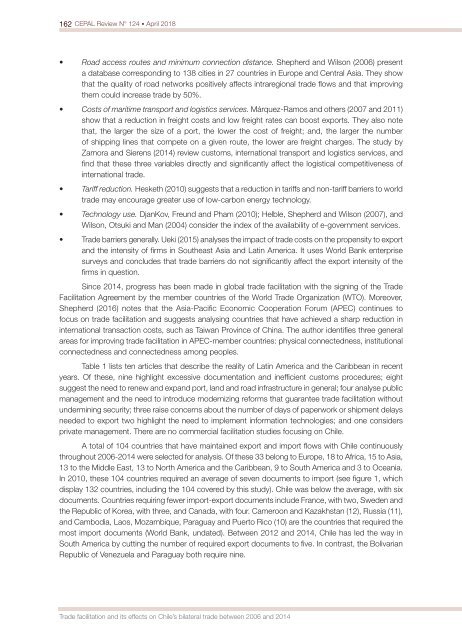CEPAL Review no. 124
April 2018
April 2018
You also want an ePaper? Increase the reach of your titles
YUMPU automatically turns print PDFs into web optimized ePapers that Google loves.
162 <strong>CEPAL</strong> <strong>Review</strong> N° <strong>124</strong> • April 2018<br />
• Road access routes and minimum connection distance. Shepherd and Wilson (2006) present<br />
a database corresponding to 138 cities in 27 countries in Europe and Central Asia. They show<br />
that the quality of road networks positively affects intraregional trade flows and that improving<br />
them could increase trade by 50%.<br />
• Costs of maritime transport and logistics services. Márquez-Ramos and others (2007 and 2011)<br />
show that a reduction in freight costs and low freight rates can boost exports. They also <strong>no</strong>te<br />
that, the larger the size of a port, the lower the cost of freight; and, the larger the number<br />
of shipping lines that compete on a given route, the lower are freight charges. The study by<br />
Zamora and Sierens (2014) review customs, international transport and logistics services, and<br />
find that these three variables directly and significantly affect the logistical competitiveness of<br />
international trade.<br />
• Tariff reduction. Hesketh (2010) suggests that a reduction in tariffs and <strong>no</strong>n-tariff barriers to world<br />
trade may encourage greater use of low-carbon energy tech<strong>no</strong>logy.<br />
• Tech<strong>no</strong>logy use. DjanKov, Freund and Pham (2010); Helble, Shepherd and Wilson (2007), and<br />
Wilson, Otsuki and Man (2004) consider the index of the availability of e-government services.<br />
• Trade barriers generally. Ueki (2015) analyses the impact of trade costs on the propensity to export<br />
and the intensity of firms in Southeast Asia and Latin America. It uses World Bank enterprise<br />
surveys and concludes that trade barriers do <strong>no</strong>t significantly affect the export intensity of the<br />
firms in question.<br />
Since 2014, progress has been made in global trade facilitation with the signing of the Trade<br />
Facilitation Agreement by the member countries of the World Trade Organization (WTO). Moreover,<br />
Shepherd (2016) <strong>no</strong>tes that the Asia-Pacific Eco<strong>no</strong>mic Cooperation Forum (APEC) continues to<br />
focus on trade facilitation and suggests analysing countries that have achieved a sharp reduction in<br />
international transaction costs, such as Taiwan Province of China. The author identifies three general<br />
areas for improving trade facilitation in APEC-member countries: physical connectedness, institutional<br />
connectedness and connectedness among peoples.<br />
Table 1 lists ten articles that describe the reality of Latin America and the Caribbean in recent<br />
years. Of these, nine highlight excessive documentation and inefficient customs procedures; eight<br />
suggest the need to renew and expand port, land and road infrastructure in general; four analyse public<br />
management and the need to introduce modernizing reforms that guarantee trade facilitation without<br />
undermining security; three raise concerns about the number of days of paperwork or shipment delays<br />
needed to export two highlight the need to implement information tech<strong>no</strong>logies; and one considers<br />
private management. There are <strong>no</strong> commercial facilitation studies focusing on Chile.<br />
A total of 104 countries that have maintained export and import flows with Chile continuously<br />
throughout 2006-2014 were selected for analysis. Of these 33 belong to Europe, 18 to Africa, 15 to Asia,<br />
13 to the Middle East, 13 to North America and the Caribbean, 9 to South America and 3 to Oceania.<br />
In 2010, these 104 countries required an average of seven documents to import (see figure 1, which<br />
display 132 countries, including the 104 covered by this study). Chile was below the average, with six<br />
documents. Countries requiring fewer import-export documents include France, with two, Sweden and<br />
the Republic of Korea, with three, and Canada, with four. Cameroon and Kazakhstan (12), Russia (11),<br />
and Cambodia, Laos, Mozambique, Paraguay and Puerto Rico (10) are the countries that required the<br />
most import documents (World Bank, undated). Between 2012 and 2014, Chile has led the way in<br />
South America by cutting the number of required export documents to five. In contrast, the Bolivarian<br />
Republic of Venezuela and Paraguay both require nine.<br />
Trade facilitation and its effects on Chile’s bilateral trade between 2006 and 2014


















